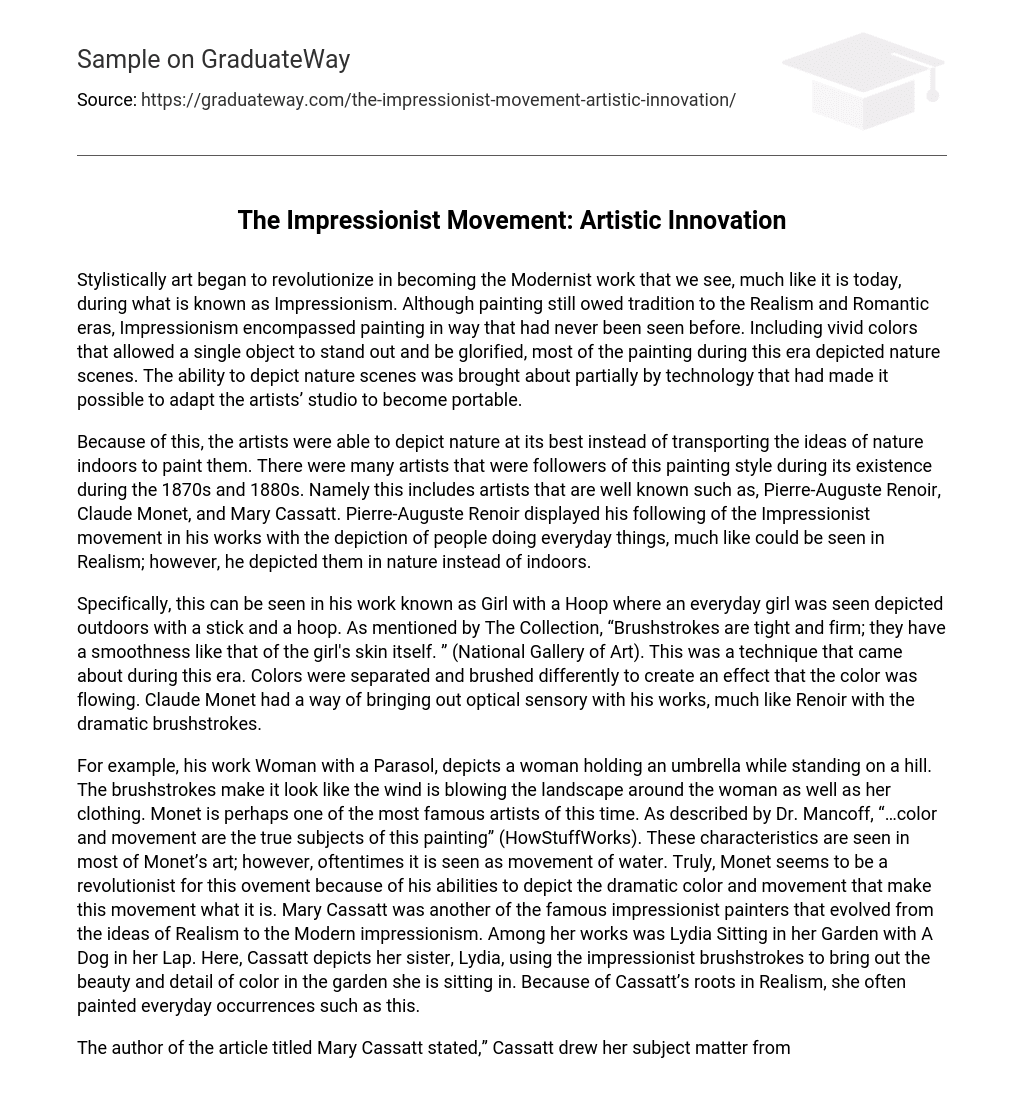During the Impressionism era, art began to undergo a stylistic revolution, ultimately becoming the Modernist work we recognize today. While still influenced by traditions of Realism and Romanticism, Impressionism introduced a fresh approach to painting. This new style featured vibrant colors that heightened the prominence of individual objects, with a prevalent focus on nature scenes. Technological advancements played a role in enabling artists to transform their studios into portable spaces, facilitating the depiction of natural landscapes.
During the 1870s and 1880s, many artists embraced the Impressionist movement and its focus on depicting nature in its full glory rather than painting indoor scenes. Notable artists who followed this style included Pierre-Auguste Renoir, Claude Monet, and Mary Cassatt. Renoir, for instance, showcased his allegiance to the movement by portraying daily activities of people, similarly seen in Realism, but chose the setting of nature instead of indoor spaces.
This can be observed in Claude Monet’s artwork titled Girl with a Hoop, where a girl is depicted outdoors with a stick and a hoop. According to The Collection, Monet’s brushstrokes in this painting are tight and firm, giving the smoothness of the girl’s skin. This technique was characteristic of the era, where colors were separated and brushed in a way that created a flowing effect. Similar to Renoir’s dramatic brushstrokes, Monet had the ability to evoke optical sensory in his works.
Monet’s famous artwork Woman with a Parasol showcases a woman holding an umbrella on a hill, with brushstrokes that convey the wind affecting both the surrounding landscape and her clothing. Monet is widely recognized as one of the most prominent artists of that time. According to Dr. Mancoff, this painting’s true focal points are its color and movement (HowStuffWorks). These characteristics can also be observed in much of Monet’s other artwork, although they are often associated with water movement. Monet stands out as a revolutionary figure in this artistic movement due to his ability to depict vibrant color and dynamic motion. On the other hand, Mary Cassatt, another celebrated impressionist painter, transitioned from Realism to Modern Impressionism. In Lydia Sitting in her Garden with A Dog in her Lap, one of her notable works, Cassatt uses impressionistic brushstrokes to highlight the intricate details and beauty of the garden where her sister Lydia is seated. Having originated in Realism, Cassatt frequently portrayed ordinary daily occurrences such as this.
The article titled Mary Cassatt states that Cassatt drew inspiration from her own family and home environment. Post impressionism emerged as a result of artists’ ambitions to broaden their horizons and incorporate new ideas that had been developing for years. Unlike the Impressionist movement, post-impressionists sought to expand upon its ideals while incorporating their own unique concepts. This movement had a significant impact on modern art and lasted from 1886 until 1900.
Among the most renowned post impressionist artists were Georges Seurat, Paul Cezanne, and Vincent van Gogh. Georges Seurat created paintings with a fuzzy appearance, in stark contrast to the detailed work of impressionism. A prime example of this technique is A Sunday Afternoon on the Island of La Grande Jatte, where the lines are precise but the painting consists of dots, creating a fuzzy effect.
The author of the web article Seurat, Georges highlights the difference of Seurat’s work compared to the Impressionist technique of suggesting light, atmosphere, and movement (WebMuseum). Notably, Paul Cezanne also possesses a distinct style. While Seurat utilizes dots to give individuality to his paintings, Cezanne employs jagged and uneven spatters of paint that create a delusional effect in his art. Upon closer examination, Cezanne’s work may seem sloppy, yet it ultimately produces a uniform and vibrant picture.
Tom Gurney, author of Paul Cezanne Prints, discusses the uniqueness of Cezanne’s work by mentioning how it bridged the gap between the popular French impressionist movement and 20th century creations like Picasso’s Cubism (Ezine@rticles). Vincent van Gogh, a renowned artist, revolutionized art during the post-impressionism movement by using a previously unseen style of using swirled lines to depict both stillness and movement in his paintings.
The Starry Night, a widely famous painting, vividly illustrates the author’s mood with swirling lines in a town beneath a sky full of stars. Benjamin Genocchio, in his article Van Gogh in Moods, Both Dark and Light, expresses his opinion that “life is elsewhere” in reference to this painting. This reflects the shift away from strict artistic ideals that had been prevalent for many years, as Impressionism emerged. Post-Impressionism further deviated from prior art trends, with a pursuit of new artistic expressions.
Despite their significant differences, both Impressionism and Post-Impressionism heavily influence modern art. Pierre-Auguste Renoir, Claude Monet, and Mary Cassatt introduced a fresh perspective on Realism and Romanticism, while Georges Seurat, Paul Cezanne, and Vincent van Gogh revolutionized art with their unique ideas. This marked the beginning of post-impressionism.





